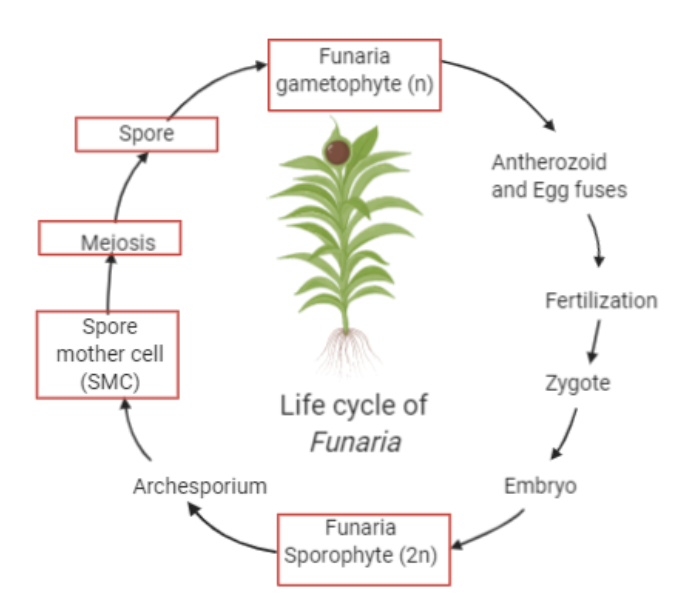
Choose the correct sequence w.r.t. life cycle of Funaria.
A. Sporophyte (main body) $\to $ SMC $\xrightarrow{meiosis}$ Spore $\to $ Gametophyte (dependent)
B. Gametophyte (main body) $\to $ Syngamy $\to $ Zygote $\to $ Sporophyte (dependent)
C. Gametophyte $\to $ SMC $\xrightarrow{meiosis}$ Spore $(2n)$ $\to $ Sporophyte
D. Sporophyte $\to $ SMC $\xrightarrow{meiosis}$ Spore $(2n)$ $\to $ Gametophyte
Answer
464.1k+ views
Hint: Funaria is a bryophyte that reproduces sexually with help of antheridium and archegonium. It is thought to be a primitive plant species. It grows from a spore and shows alternation of generation.
Complete answer:
The genus Funaria are bryophytes means that they can live in water as well as in soil. They are usually found as a green mat-like structure on rocks and trees. About 177 species are known. They are also called green moss or cord moss. It reproduces either by sexual or asexual reproduction. The sexual life cycle is predominantly haplo-diplontic. But the main plant body called gametophyte is free-living and haploid (n).

-The gametophyte part of the Funaria body consists of gametes called antheridium (male gamete) and archegonium (female gamete). The sporogonium part consists of spores.
-On maturation, the diploid sporophytes $(2n)$ produce spores through meiosis that are haploid and are dispersed. When they fall into suitable habitat the spores start growing by mitosis forming a protonema structure that is called gametophyte that is haploid.
-Through continuous mitosis, the protonema forms mature male and female gametophytes in antheridia and archegonia respectively. After this, both the gametes fuse to form a diploid zygote $(2n)$.
-The zygote formed then undergoes mitosis in the mature female gametophyte body. From this gametophyte, the sporophyte generation develops and again forms spores by meiosis to continue another cycle.
Thus, the right order of the life cycle of Funaria is Sporophyte $\to $ SMC $\xrightarrow{meiosis}$ Spore $(2n)$ $\to $ Gametophyte.
Hence, option D is the right answer.
Note: Funaria belongs to Bryophyte plants. Thus, its characteristic feature is to undergo alternation of generation. This means that a sporophyte forms a gametophyte and a gametophyte forms a sporophyte.
Complete answer:
The genus Funaria are bryophytes means that they can live in water as well as in soil. They are usually found as a green mat-like structure on rocks and trees. About 177 species are known. They are also called green moss or cord moss. It reproduces either by sexual or asexual reproduction. The sexual life cycle is predominantly haplo-diplontic. But the main plant body called gametophyte is free-living and haploid (n).

-The gametophyte part of the Funaria body consists of gametes called antheridium (male gamete) and archegonium (female gamete). The sporogonium part consists of spores.
-On maturation, the diploid sporophytes $(2n)$ produce spores through meiosis that are haploid and are dispersed. When they fall into suitable habitat the spores start growing by mitosis forming a protonema structure that is called gametophyte that is haploid.
-Through continuous mitosis, the protonema forms mature male and female gametophytes in antheridia and archegonia respectively. After this, both the gametes fuse to form a diploid zygote $(2n)$.
-The zygote formed then undergoes mitosis in the mature female gametophyte body. From this gametophyte, the sporophyte generation develops and again forms spores by meiosis to continue another cycle.
Thus, the right order of the life cycle of Funaria is Sporophyte $\to $ SMC $\xrightarrow{meiosis}$ Spore $(2n)$ $\to $ Gametophyte.
Hence, option D is the right answer.
Note: Funaria belongs to Bryophyte plants. Thus, its characteristic feature is to undergo alternation of generation. This means that a sporophyte forms a gametophyte and a gametophyte forms a sporophyte.
Recently Updated Pages
Glucose when reduced with HI and red Phosphorus gives class 11 chemistry CBSE

The highest possible oxidation states of Uranium and class 11 chemistry CBSE

Find the value of x if the mode of the following data class 11 maths CBSE

Which of the following can be used in the Friedel Crafts class 11 chemistry CBSE

A sphere of mass 40 kg is attracted by a second sphere class 11 physics CBSE

Statement I Reactivity of aluminium decreases when class 11 chemistry CBSE

Trending doubts
The reservoir of dam is called Govind Sagar A Jayakwadi class 11 social science CBSE

10 examples of friction in our daily life

Difference Between Prokaryotic Cells and Eukaryotic Cells

State and prove Bernoullis theorem class 11 physics CBSE

Proton was discovered by A Thomson B Rutherford C Chadwick class 11 chemistry CBSE

State the laws of reflection of light




